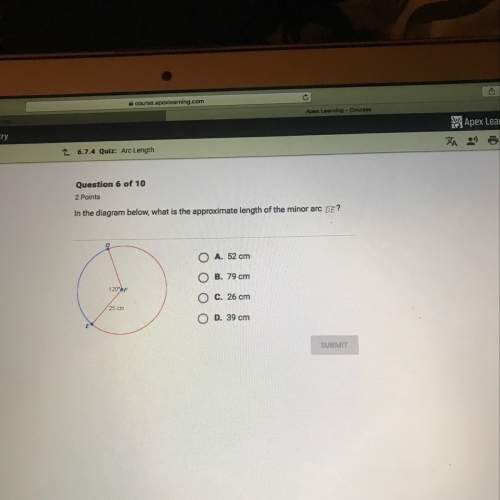
Mathematics, 30.12.2020 21:50 emilyy47
First, construct a triangle as indicated by your choice in step 1 on a coordinate plane. For example, if you chose to use an obtuse scalene triangle translation to prove SSS Congruence, then you will construct an obtuse scalene triangle. Make sure to measure your triangle's angles and sides. You can use the concept of distance and slope to ensure your triangle satisfies the criteria indicated by your choice. Write down the original coordinates of this triangle. Next, identify and label three points on the coordinate plane that are the transformation of your original triangle. Make sure you use the transformation indicated within the scenario you selected. For example, if you chose to use an obtuse scalene triangle translation to prove SSS Congruence, then you complete a translation of your triangle. Remember, you only need to complete one transformation on your triangle. Write down these new coordinates for this second triangle. If you chose Obtuse Scalene Triangle Translation to prove SSS Congruence, use the coordinates of your transformation along with the distance formula to show that the two triangles are congruent by the SSS postulate. You must show all work with the distance formula and each corresponding pair of sides to receive full credit. If you chose Isosceles Right Triangle Reflection to prove ASA Congruence, use the coordinates of your reflection to show that the two triangles are congruent by the ASA postulate. You can use the distance formula to show congruency for the sides. To show an angle is congruent to a corresponding angle, you can use slope or your compass and straightedge. (Hint: Remember when you learned how to copy an angle?) You must show all work with the distance formula for the corresponding pair of sides, and your work for the corresponding angles to receive full credit. If you chose Equilateral Equiangular Triangle Rotation to prove SAS Congruence, use the coordinates of your rotation to show that the two triangles are congruent by the SAS postulate. You can use the distance formula to show congruency for the sides. To show an angle is congruent to a corresponding angle, you can use slope or your compass and straightedge. (Hint: Remember when you learned how to copy an angle?) You must show all work with the distance formula for the corresponding pair of sides, and your work for the corresponding angles, to receive full credit. You must submit the construction of the original triangle and your transformation. You may create this graph using graphing technology. You may also print and use graph paper. Provide an answer to the questions that match your selected scenario. Because you only completed one scenario, only one group of questions should be answered in complete sentences and submitted with your work. Obtuse Scalene Triangle Translation to prove SSS Congruence Describe the translation you performed on the original triangle. Use details and coordinates to explain how the figure was transformed, including the translation rule you applied to your triangle. What other properties exist in your triangle? Discuss at least two theorems you learned about in this module that apply to your triangle. Make sure to show evidence by discussing your triangle's measurements. Did your triangle undergo rigid motion? Explain why. Isosceles Right Triangle Reflection to prove ASA Congruence Answer the following questions: What line of reflection did you choose for your transformation? How are you sure that each point was reflected across this line? What reflection rule did you apply to your triangle? What other properties exist in your triangle? Discuss at least two theorems you learned about in this module that apply to your triangle. Make sure to show evidence by discussing your triangle's measurements. Did your triangle undergo rigid motion? Explain why. Equilateral Equiangular Triangle Rotation to prove SAS Congruence Answer the following questions: How many degrees did you rotate your triangle? In which direction (clockwise, counterclockwise) did it move? What rotation rule did you apply to your triangle? What other properties exist in your triangle? Discuss at least two theorems you learned about in this module that apply to your triangle. Make sure to show evidence by discussing your triangle's measurements. Did your triangle undergo rigid motion? Explain why.

Answers: 1


Other questions on the subject: Mathematics

Mathematics, 21.06.2019 12:30, lanaiheart7
The empire state building in new york city is 1454 feet tall a model of a building is 24 inches tall what is the ratio of the height of the model to the height of the actual empire state building
Answers: 1

Mathematics, 21.06.2019 14:00, Pauline3607
Use the knowledge of x- and y- intercepts to choose the correct graph of the equation 3x+6y=6
Answers: 1

Mathematics, 21.06.2019 20:00, whosdarrin9396
If cos(2x) = tan^2(y), show that cos(2y) = tan^2(x).
Answers: 3

Mathematics, 21.06.2019 21:30, gungamer720
Aladder that is 20ft long is leaning against the side of a building. if the angle formed between the ladder and the ground is 75 degrees how far is the bottom of the from the base of the building?
Answers: 1
You know the right answer?
First, construct a triangle as indicated by your choice in step 1 on a coordinate plane. For example...
Questions in other subjects:

Mathematics, 08.10.2019 05:00



History, 08.10.2019 05:10

Biology, 08.10.2019 05:10





Chemistry, 08.10.2019 05:10




